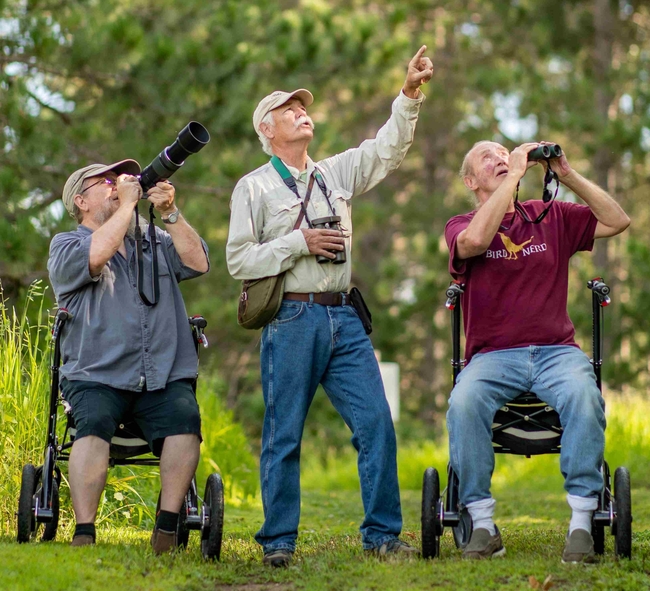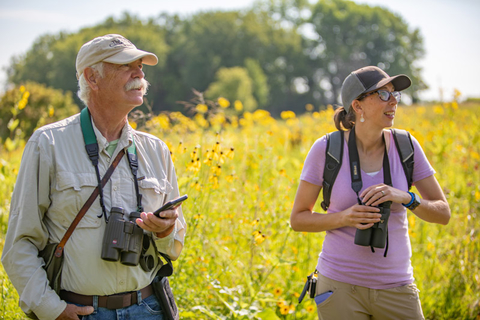Minnesota Master Naturalist Volunteers who served in the armed forces help fellow veterans connect with the outdoor world
They probably seemed an unlikely crew — a handful of seniors, some with walkers, trooping through tall grass at Gray Cloud Dunes Scientific and Natural Area with binoculars in hand. These former military servicemembers were on a different sort of reconnaissance, in search of a rare scissor-tailed flycatcher that had been spotted there the day before.
“We didn’t see it, but we saw others, including a Bell’s vireo,” says retired Hastings city forester and parks superintendent Kevin Smith, who was guiding them.
Smith has been cultivating an interest in birding among residents of the Hastings Veterans Home as a volunteer with University of Minnesota Extension’s Minnesota Master Naturalist program.
“It’s a good health benefit,” Smith says. “That’s really the reason I go out. I can hear the birds, see the change of seasons.”
“Kevin is an amazing human being who has this patient, infectious passion for guiding people,” says Katie Wrich, a recreation therapist at the Hastings Veterans Home. She notes that Smith meets each person at their level and provides a birding experience catered to them.
“The transformation I’ve seen with some veterans is truly astounding,” Wrich says. “I’ve had veterans that engage in programming here — chair exercise, using the fitness room — so they can build the endurance to go out birding every Tuesday morning.”
Smith’s choice of volunteer work is a perfect fit with his career in natural resources, and he’s been an avid birder since his mom introduced him to the hobby. As a veteran, he can connect with other veterans in a unique way. “We can relate and share stories,” he says.
Smith is one of nearly 1,000 Master Naturalists who together contributed more than 89,000 hours in 2022 to volunteering right here in Minnesota.
“These volunteers, through training, become community scientists, educating others about our amazing natural world and why conservation matters to all of us,” says Amy Rager, Extension educator and volunteer manager for the program.
Reeling in stress
“Veterans find learning new skills and engaging in outdoor activities with guidance from volunteers to be a big boon,” says Don Parsons, Master Naturalist volunteer and U.S. Air Force retiree. Parsons taught fly fishing and fly tying during a weekend program for veterans and their families at Whitewater State Park last October and is looking forward to doing the same this fall.
“In some ways fly fishing can be intense, but it can take your mind away from other things,” Parsons says. “It’s calming, and the military is stressful.”
20,000 hours
They say it takes 10,000 hours to get to be really good at something. With nearly 20,000 hours as a Master Naturalist volunteer under her belt, photographer and dog lover Kathleen Riley must be about as expert as it gets.
Riley took the training more than a decade ago after seeing an invitation in her local Ramsey Resident newsletter. “They said it was good for people who love the outdoors and for photographers,” she says.
She aligns her volunteer work with her other passions: picking up trash, pulling invasive plants and taking pictures while walking her dogs, and teaching others how to travel with their own furry friends.
“Everybody should try it,” she says. “Even if they just go through the classes, at least they gain more insight into how the planet works.”
Mysterious mulberries
To become a certified Master Naturalist volunteer, individuals go through 40 hours of training and complete a capstone project that benefits Minnesota’s natural resources or environmental education initiatives.
For Brainerd attorney Paul Jacobsen and four fellow participants, the focus was on improving the ability to identify what could be Minnesota’s rarest tree, the red mulberry. Native to southeastern Minnesota, the red mulberry has been hybridizing with non-native white mulberry trees since the 1800s. Because the two are so similar, it’s not clear whether reports of sightings to the species identification app iNaturalist are the true red mulberry, white mulberries or hybrids.
“We wanted to get information so people could distinguish them,” Jacobsen says.
Working under the guidance of Angela Gupta, Extension forestry educator, the fledgling Master Naturalist volunteers tracked down photos that citizens can use to distinguish mulberry varieties. They helped sort out the true identities of trees previously reported to iNaturalist – finding that non-natives and hybrids outnumber the native species an astounding 52 to 1.
“The outdoor world has always been an interest, so I thought it would be an area in which I can give,” says Jacobsen. Next up for him: helping with woodlot maintenance, teaching woodworking and volunteering at the National Loon Center in Crosslake.





